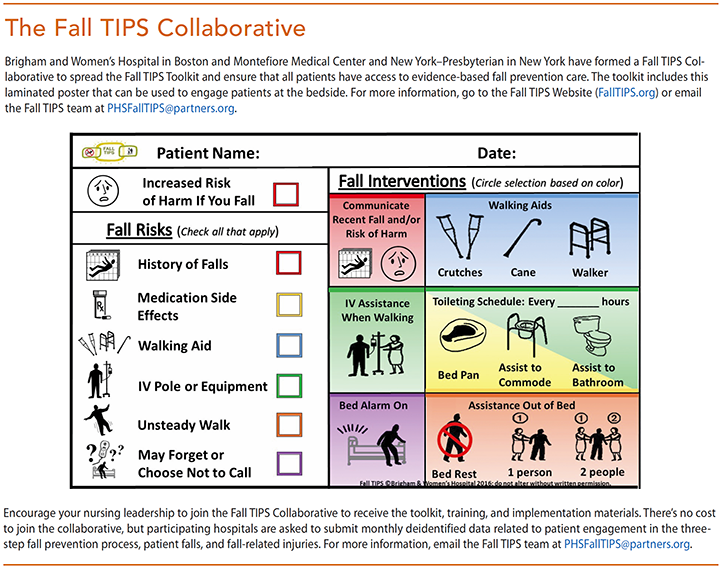
Falls in hospitalized patients are a pressing patient safety concern but there is a limited body of evidence demonstrating the effectiveness of commonly used fall prevention interventions in hospitals. Hospital staff can re-emphasize key components of the patients individualized prevention plan during rounds and rehab sessions like using the call light instead of getting up alone to remind patients to follow these interventions.

The simple act of walking around can become cumbersome and in fact dangerous.
Preventing falls in hospital. Ad Hospitality course in NT Australia Paid F-Time hospitality internship. Fall prevention involves managing a patients underlying fall risk factors and optimizing the hospitals physical design and environment. This toolkit focuses on overcoming the challenges associated with developing implementing and sustaining a fall prevention program.
Research shows that close to one-third of falls can be prevented. Iii As of 2008 the Centers for Medicare. Many of these injuries could occur after a fall.
Falls in any situation can cause injury and many people end up in hospital due to a fall. If you have a fall while in hospital it may lengthen your hospital stay. All people are vulnerable to falls regardless of age though as you get older there is often a higher risk of falling.
Fall risks for older people in hospital. Preventing falls in hospital. Essential facts Falls are the most frequent adverse event reported in hospitals usually affecting older patients.
Every year more than 240000 falls are reported in acute hospitals and mental health trusts in England and Wales equivalent to more than 600 a day according to the Royal College of. Ganz DA Huang C Saliba D et al. Preventing falls in hospitals.
A toolkit for improving quality of care. Prepared by RAND Corporation Boston University School of Public Health and ECRI. Reducing Your Risk of Falls in the Hospital Ways that you can reduce the risk of falling during a hospital stay include staying in bed or staying seated.
Caregivers can make sure that you have easy access to things you need like the care light the phone and water. Falls in hospitalized patients are a pressing patient safety concern but there is a limited body of evidence demonstrating the effectiveness of commonly used fall prevention interventions in hospitals. This article reviews common study designs and.
Educate hospital leadership and Implementation Team on the Preventing Falls in Hospitals Toolkit to facilitate the change process in hospitals. Develop hospital-specific action plans for implementing a Fall Prevention Program using the Toolkit. Address specific challenges of preventing falls in your hospital.
Falls in hospital impact on quality of life and health and cost the NHS more than 23 billion per year An individualised falls risk assessment is essential to identify targeted prevention. Preventing falls in hospital Information for patients and carers Poor unsteady mobility Vision problems Low blood pressure Lack of orientation strange environment Untidy environment Fear of falling History of falling Urine frequency incontinence All of these can increase the risk of you falling in hospital. About the Preventing Falls in Hospitals programme Falls are the most commonly reported type of patient safety incident in healthcare.
Around 250000 patients fall in acute and community hospitals each year NHS England National Reporting and Learning System 2013 2014. Over 800 hip fractures and about 600 other fractures are reported. A fall prevention handout can be an easy way to start their education.
Hospital staff can re-emphasize key components of the patients individualized prevention plan during rounds and rehab sessions like using the call light instead of getting up alone to remind patients to follow these interventions. More Fall Prevention Resources. Preventing Falls in the Hospital.
For a variety of reasons patients in a hospital are at risk of falling. Whether it is old age new medications weakness following surgery stress or anxiety patients are not in peak physical form. The simple act of walking around can become cumbersome and in fact dangerous.
Some of the key interventions in preventing falls in hospitals includes keeping the bed position at a low spot when the patient is resting and adjusting the bed level to a comfortable height when the patient needs to leave the bed Cameron et al 2018. Postoperative patients need safety companions to provide continuous observation and aid to prevent falls. A combination of strategies is needed to help prevent falls in hospitals.
Strategies may focus on the environment the level of care the use of equipment and aids. All strategies should consider the individual patients health and personal needs. Ad Hospitality course in NT Australia Paid F-Time hospitality internship.